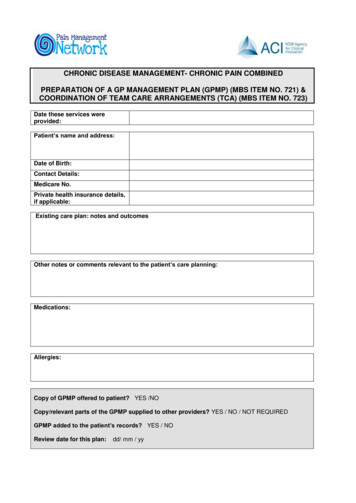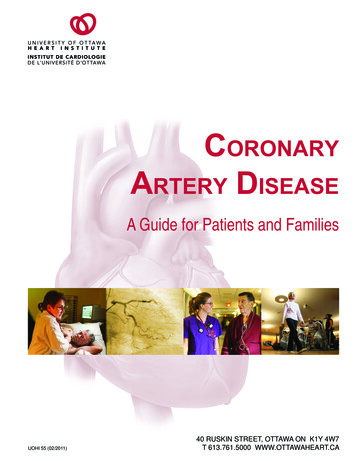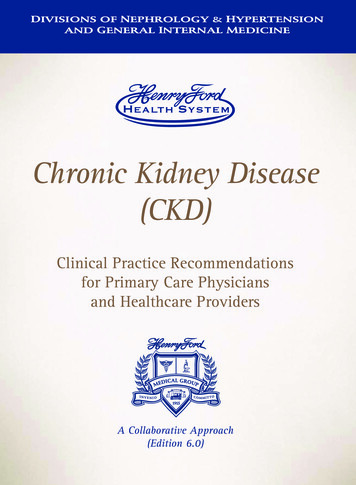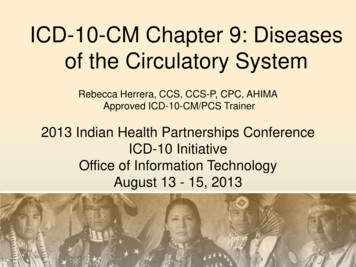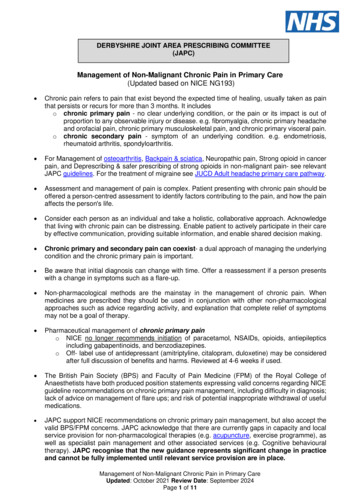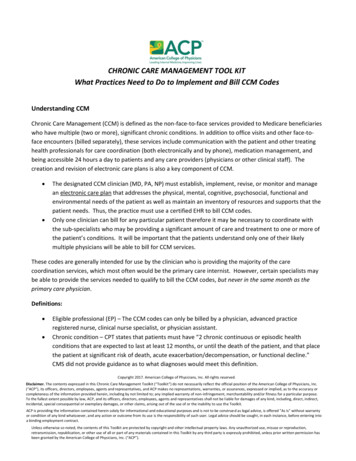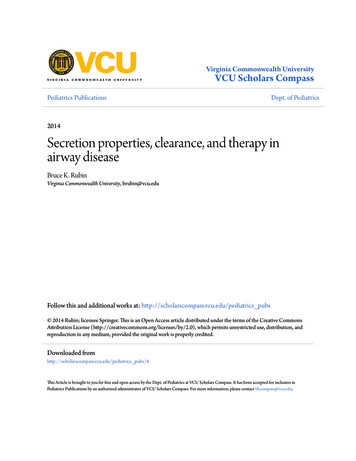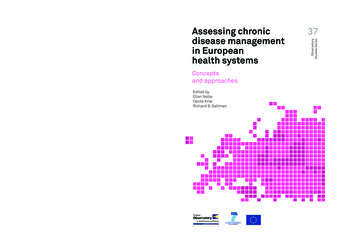
Transcription
Cover WHO nr37 bis Mise en page 1 5/02/15 15:39 Page 137Assessing chronic disease management in European health systems explores some of the keyissues, ranging from interpreting the evidence base to assessing the policy context for, andapproaches to, chronic disease management across Europe. Drawing on 12 detailed country reports(available in a second, online volume), the study provides insights into the range of care modelsand the people involved in delivering these; payment mechanisms and service user access; andchallenges faced by countries in the implementation and evaluation of these novel approaches.This book builds on the findings of the DISMEVAL project (Developing and validating DISeaseManagement EVALuation methods for European health care systems), led by RAND Europe andfunded under the European Union’s (EU) Seventh Framework Programme (FP7) (Agreementno. 223277).The editorsEllen Nolte, Hub Cordinator, European Observatory on Health Systems and Policies.Cécile Knai, Senior Lecturer, London School of Hygiene & Tropical Medicine.9ISBN 9289050302Observatory Studies Series No. 37789289 050302Richard B. Saltman, Professor of Health Policy and Management at the Rollins School of PublicHealth of Emory University in Atlanta and Associate Head of Research Policy at the EuropeanObservatory on Health Systems and Policies.Assessing chronicdisease managementin Europeanhealth systemsConceptsand approachesEdited byEllen NolteCécile KnaiRichard B. Saltman37ObservatoryStudies SeriesEdited by Ellen Nolte, Cécile Knai, Richard B SaltmanThere is a clear need to redesign delivery systems in order to better meet the needs created bychronic conditions, moving from the traditional, acute and episodic model of care to one that bettercoordinates professionals and institutions and actively engages service users and their carers.Many countries have begun this process but it has been difficult to reach conclusions about thebest approach to take: care models are highly context-dependent and scientifically rigorousevaluations have been lacking.ASSESSING CHRONIC DISEASE MANAGEMENT IN EUROPEAN HEALTH SYSTEMSThe rising burden of chronic illness, in particular the rapid increase in the number of people withmultiple health problems, is a challenge to health systems globally. Associated premature mortalityand reduced physical functioning, along with higher use of health services and related costs, areamong the key concerns faced by policy-makers and practitioners.
Assessing chronic disease management in Europeanhealth systems
The European Observatory on Health Systems and Policies supports and promotes evidencebased health policy-making through comprehensive and rigorous analysis of health systems inEurope. It brings together a wide range of policy-makers, academics and practitioners to analysetrends in health reform, drawing on experience from across Europe to illuminate policy issues.The European Observatory on Health Systems and Policies is a partnership, hosted by the WHORegional Office for Europe, which includes the Governments of Austria, Belgium, Finland,Ireland, Norway, Slovenia, Sweden, the United Kingdom and the Veneto Region of Italy; theEuropean Commission; the World Bank; UNCAM (French National Union of Health InsuranceFunds); the London School of Economics and Political Science; and the London School ofHygiene & Tropical Medicine.
Assessing chronic diseasemanagement in European healthsystemsConcepts and approachesEdited byEllen NolteCécile KnaiRichard B. SaltmanEuropeanon Health Systems and Policiesa partnership hosted by WHO
iv Assessing chronic disease management in European health systemsKeywords:CHRONIC DISEASEDELIVERY OF HEALTH CARE, INTEGRATEDHEALTH CARE SYSTEMSHEALTH POLICYPUBLIC HEALTH World Health Organization 2014 (acting as the host organization for, and secretariat of, the EuropeanObservatory on Health Systems and Policies)All rights reserved. The European Observatory on Health Systems and Policies welcomes requests forpermission to reproduce or translate its publications, in part or in full.Address requests about publications to: Publications, WHO Regional Office for Europe, UN City,Marmorvej 51, DK-2100 Copenhagen Ø, Denmark.Alternatively, complete an online request form for documentation, health information, or for permissionto quote or translate, on the Regional Office web site (http://www.euro.who.int/pubrequest).The designations employed and the presentation of the material in this publication do not imply theexpression of any opinion whatsoever on the part of the European Observatory on Health Systems andPolicies concerning the legal status of any country, territory, city or area or of its authorities, or concerningthe delimitation of its frontiers or boundaries. Dotted lines on maps represent approximate border lines forwhich there may not yet be full agreement.The mention of specific companies or of certain manufacturers’ products does not imply that they areendorsed or recommended by the European Observatory on Health Systems and Policies in preference toothers of a similar nature that are not mentioned. Errors and omissions excepted, the names of proprietaryproducts are distinguished by initial capital letters.All reasonable precautions have been taken by the European Observatory on Health Systems and Policies toverify the information contained in this publication. However, the published material is being distributedwithout warranty of any kind, either express or implied. The responsibility for the interpretation and use ofthe material lies with the reader. In no event shall the European Observatory on Health Systems and Policiesbe liable for damages arising from its use. The views expressed by authors, editors, or expert groups do notnecessarily represent the decisions or the stated policy of the European Observatory on Health Systems andPolicies or any of its partners.ISBN 978 92 890 5030 2Printed in the United KingdomCover design by M2M
ContentsPrefaceviiAcknowledgementixList of tables and boxesxiList of abbreviationsxiiiVolume I contributorsxv1 Introduction1.1 Background1.2 Approach to this book1.2.1 Conceptualizing chronic disease and chronic disease management1.2.2 Countries included in the review1.3 About this book1134772 What we know: a brief review of the evidence of approaches to chronic care2.1 Managing care for people with chronic conditions: concepts and definitions2.1.1 Disease management2.1.2 Integrated care2.2 What we do know: a review of the evidence base on approaches tocaring for people with chronic conditions2.2.1 Disease management2.2.2 Integrated care2.2.3 Economic impacts of disease management or integrated care2.3 What we need to know: limitations of the existing evidence base2.4 Conclusions9910113 Approaches to chronic disease management in Europe3.1 Key features of the health care systems in 12 European countries3.2 The policy context for chronic care in Europe3.3 Overview of approaches to chronic disease management in 12 Europeancountries3.4 Financing, distribution and uptake of approaches to chronic diseasemanagement3.5 Components of chronic disease management3.6 Conclusions3.6.1 The majority of approaches tend to focus on populations withdefined conditions2323251212151819213042557070
vi Assessing chronic disease management in European health systems3.6.23.6.33.6.43.6.5There is a trend towards strengthening the role of nurses in caredelivery and coordinationApproaches that seek to reduce barriers between sectors remainless commonThe implementation of approaches frequently involves financialincentivesLevels of patient and clinician support vary4 Looking ahead4.1 Learning from existing approaches4.1.1 Incorporating the patient perspective4.2 Providing the (regulatory) context to enable innovationReferences717172727374808385
PrefaceThis book comprises two volumes and builds on the findings of the DISMEVALproject (Developing and validating DISease Management EVALuation methodsfor European health care systems), funded under the European Union’s (EU)Seventh Framework Programme (FP7) (Agreement no. 223277). DISMEVALwas a three-year European collaborative project conducted between 2009 and2011. It contributed to developing new research methods and generatingthe evidence base to inform decision-making in the field of chronic diseasemanagement evaluation (www.dismeval.eu).In this book, we report on the findings of the project’s first phase, capturingthe diverse range of contexts in which new approaches to chronic care are beingimplemented and evaluating the outcomes of these initiatives using an explicitcomparative approach and a unified assessment framework. In this first volume,we describe the range of approaches to chronic care adopted in 12 Europeancountries. By reflecting on the facilitators and barriers to implementation, weaim to provide policy-makers and practitioners with a portfolio of options toadvance chronic care approaches in a given policy context.In volume II (available online at vatory/studies), we present detailed overviews of each of the 12countries reviewed for this work and which informed the overview presented inthe first volume of the book.Ellen NolteEuropean Observatory on Health Systems and PoliciesCécile KnaiLondon School of Hygiene & Tropical MedicineRichard B. SaltmanEmory University in Atlanta
AcknowledgementsLed by RAND Europe, the DISMEVAL project brought together 10 partnersin seven EU countries and a range of associates in five additional countries.The following members of and associates to this project contributed directlyor indirectly to this book through the collection and synthesis of informationand data, the drafting of country reports as presented in volume II of the book,and the review of chapters (affiliation at the time of the DISMEVAL project):RAND Europe, Cambridge, UK: Laura Brereton, Annalijn Conklin, SabaHinrichs, Ellen Nolte, Janice Pedersen, Martin Roland (special adviser toRAND Europe)London School of Hygiene & Tropical Medicine, London, UK: Cécile KnaiParacelsus Medizinische Privatuniversität, Salzburg, Austria: Maria Flamm,Andreas SönnichsenKøbenhavns Universitet, Copenhagen, Denmark: Anne Frølich, RamuneJacobsenUniversité Paris Est Créteil Val de Marne, Paris, France: Matthias Brunn,Benjamin Cadier, Karine Chevreul, Isabelle Durand-ZaleskiGoethe Universität, Frankfurt am Main, Germany: Antje Erler, Birgit FullertonUniversiteit Maastricht, the Netherlands: Arianne M.J. Elissen, Inge G.P.Duimel-Peeters, Cor Spreeuwenberg, Hubertus J.M. VrijhoefCentre Léon Bérard Lyon et Rhône-Alpes, Lyon, France: Fadila Farsi, HélèneLabrosseInstituto de Salud Carlos III, Madrid, Spain: Zuleika Saz Parkinson, AntonioSarria SantameraAQUA Institut für angewandte Qualitätsförderung und Forschung imGesundheitswesen, Göttingen, Germany: Robert Krohn, Boris PöhlmannIn addition, the following experts contributed reports on individual countriesnot covered by the DISMEVAL partnership:Estonia: Taavi Lai
x Assessing chronic disease management in European health systemsHungary: Márton Csere, Peter GaalItaly: Antonio Giulio de Belvis, Walter Ricciardi, Maria Lucia Specchia, TDLuca ValerioLatvia: Maris TaubeLithuania: Liubove Murauskiene, Maria VeniuteSwitzerland: Isabelle Peytremann-Bridevaux, Bernard Burnand, Ignazio CassisFurther, we would like to thank Jonathan North and Caroline White, as well asPeter Powell (typesetting) and Sonia Cutler (editing).
List of tables and boxesTablesTable 1.1Differentiating acute and chronic conditionsTable 2.1Review of reviews: evidence of the effect of disease managementprogrammes13Table 3.1Principles of health care financing in 12 European countries24Table 3.2Selected features of health care systems in 12 European countries26Table 3.3Overview of approaches to chronic disease management or theirequivalent in 12 European countries33Table 3.4Financing, distribution and uptake of approaches to chronicdisease management or their equivalent in 12 European countries43Table 3.5Components of chronic disease management used in 12 Europeancountries574BoxesBox 1.1Approaches to chronic disease management or chronic care:definition of terms5Box 4.1Reported barriers to evaluation in five European countries79Box 4.2Balancing the gap between policy intent and actual implementation:evidence from the DISMEVAL project84
List of UFFSFIQCSGDPGPHASHMOICCICPIGEAIHDLKFMIGACAcquired immunodeficiency syndromeHealth Action by Teams of Self-employed Health Professionals (France)Local Health Authority (Italy)Exceptional Medical Expenses Act (Netherlands)Blaylock Risk Assessment Screening ScoreContracts for Improved Individual Practice (France)Coronary heart diseaseSwiss francChronic Care ModelCare coordination pilotCare management programmeCaisse Nationale d’Assurance Maladie (France)Coordinating Care for Older People (France)Chronic obstructive pulmonary diseaseCardiovascular diseaseDiagnosis and treatment combinations (Netherlands)Diabetes Interactive Education ProgrammeDanish Quality Model (Denmark)Danish kroneDisease management programmeDiagnosis-related groupUniform Assessment Scale (Germany)Evaluation of professional practice (France)Estonian Health Insurance FundEuropean UnionFee-for-serviceIntervention Fund for Quality and Care Coordination (France)Gross domestic productGeneral practitionerNational Authority for Health (France)Health maintenance organizationIntegrated care contractIntegrated care pilotDiabetes Integration, Management and Assistance (Italy)Ischaemic heart diseasePerformance-based financing (Austria)Missions d’intérêt général et à l’aide à la contractualisation (France)
xiv Assessing chronic disease management in European health SPRSASHISIKSSSISSNURCAMVerAHVHIWMOZiONational Health Insurance Fund Administration (Hungary)Austrian Society of DiabetesOut-of-pocketPayment by result (England)Primary Care Trust (England)Primary health carePartnership for Older People Project (England)Purchasing power parityPersonalized care programme (France)Quality-adjusted life yearsQuality and Outcomes Framework (England)Multidisciplinary team meeting (France)Payment based on specific public health objectives (France)Risk structure compensation scheme (Germany)Statutory health insuranceIntegrated Effort for People Living with Chronic Disease (Denmark)State Serum Institute (Denmark)National Health Service (Italy)Regional Unions of Insurance Funds (France)Care assistants in family practice (Germany)Voluntary health insuranceSocial Support Act (Netherlands)Care in Development (Netherlands)
Volume I contributorsCécile Knai is Senior Lecturer, Policy Innovation Research Unit, Faculty ofPublic Health and Policy, London School of Hygiene & Tropical Medicine,London, UK.Ellen Nolte was the lead author and editor of the Volume. She is HubCoordinator at the European Observatory on Health Systems and Policies,London School of Economics and Political Science, and London School ofHygiene & Tropical Medicine, London, UK.Emma Pitchforth is Research Leader in the Health and Healthcare ResearchProgramme at RAND Europe, Cambridge, UK.Richard B. Saltman is Professor of Health Policy and Management at theRollins School of Public Health of Emory University in Atlanta, Georgia, USA.He is also Associate Head of Research Policy at the European Observatory onHealth Systems and Policies.
Chapter 1IntroductionEllen Nolte, Cécile Knai1.1 BackgroundResponding to the burden of chronic disease presents challenges for all healthsystems. As populations age and advances in health care allow those with oncefatal conditions to survive, the prevalence of chronic conditions is rising inmany countries (Yach et al., 2004). In the European Union (EU), in 2006,from 20 to over 40% of the population aged 15 years and over reported a longstanding health problem and one in four received long-term medical treatment(TNS Opinion & Social, 2007). Other studies have found the prevalence ofcommon chronic disorders was found to be around 50% among adults aged 18and over in seven high-income countries, including Germany, the Netherlandsand the UK (Schoen et al., 2007).Although the rising burden of chronic disease is driven, in part, by populationageing it is important to recognize that such conditions are not limited to theolder population. Thus, increasing numbers of children and young people aredeveloping some form of chronic health problem (Barnett et al., 2012; VanCleave, Gortmaker & Perrin, 2010), with over 80% of premature mortalityestimated to be attributable to noncommunicable diseases in Europe (Institutefor Health Metrics and Evaluation, 2013a).Assessing the precise level, distribution and nature of the chronic disease burdenin Europe remains a challenge (Pomerleau, Knai & Nolte, 2008); yet, it isclear that chronic diseases are important, greatly impacting on the years of lifelived in good health. In high-income countries, mental disorders (for example,depression and anxiety disorder), musculoskeletal disorders (for example,lower-back pain), chronic obstructive pulmonary disease (COPD) or asthma,and diabetes, are among the leading causes of chronic disability (Institute forHealth Metrics and Evaluation, 2013b), with diabetes projected to rise furtherin importance during the next two decades, especially against the background
2 Assessing chronic disease management in European health systemsof increasing levels of overweight and obesity (Danaei et al., 2013; Finucane etal., 2011).The implications for health systems and society as a whole are considerable.Chronic diseases pose a sizeable burden for national economies, with associatedcosts estimated at up to 7% of a country’s gross domestic product (Suhrcke et al.,2006). Societal costs arise partly as a result of direct health care costs, includingfrom health care use, medication and potentially costly interventions, withadditional indirect costs deriving from, for example, increased absenteeism,and reduced productivity at work (Suhrcke, Fahey & McKee, 2008). Thesechallenges add to the complexity facing health systems, which require effectivemeasures to prevent disease through reducing the major chronic disease riskfactors and addressing influences that drive exposure (Novotny, 2008), whilealso providing services to meet the requirements caused by chronic healthproblems, thereby ensuring that people with established disease can participatein society.The goals of care for those with chronic conditions are not to cure but toenhance functional status, minimize distressing symptoms, prolong lifethrough secondary prevention and enhance the quality of life (Grumbach,2003). These goals are unlikely accomplished through the traditional acute,episodic model of care, which tends to see the patient as passive recipient ofcare and where treatment aims at return to normal (Holman & Lorig, 2000).In particular, where people have multiple health problems, creating a rangeof diverse and sometimes contradictory needs, the conventional care model isinsufficient (Piette, Richardson & Valenstein, 2004). Instead, what is needed isa delivery model that involves coordinated inputs from a wide range of healthprofessionals over an extended period of time and that places patients at thecentre as co-producers of care to optimize health outcomes (Nolte & McKee,2008a).However, service delivery has developed in ways that have tended to fragmentcare, both within and between sectors, for example, through structural andfinancial barriers at the interface between primary and secondary care andbetween health and social care, distinct organizational and professionalcultures and differences in terms of governance and accountability (Glasby,Dickinson & Peck, 2006). There is thus a need for new service delivery modelsthat are characterized by collaboration and cooperation among professions andinstitutions that have traditionally worked separately.The growing recognition of this need is causing many countries to explorenew approaches to health care delivery that can bridge the boundaries betweenprofessions, providers and institutions and therefore provide appropriate
Introduction 3support to patients with long-standing health problems. We have previouslyshown how countries vary in their attempts to do so, with many implementingsome form of (chronic) disease management although the nature and scopeof related approaches differ (Nolte, Knai & McKee, 2008). We have foundthat the strategies that are being implemented tend to reflect the characteristicsof individual health systems with regard to the relationships between, andthe responsibilities of, different stakeholders in the regulation, funding anddelivery of health care. In particular, there is a suggestion that those healthsystems in which patients have traditionally chosen their provider withoutformal enrolment, paying for services episodically using fee-for-service as thepredominant method of reimbursement, may face the greatest challenges inadapting towards providing effective chronic care (Busse & Mays, 2008).However, there is a need to develop this evidence base further, using an explicitcomparative approach and a unified framework for assessment to betterunderstand the diverse range of contexts in which new approaches to chroniccare are being implemented, and to evaluate the outcomes of these initiatives.There is also a need to better understand the content of these new models,which are frequently applied from different disciplinary and professionalperspectives and are associated with different goals. In this book, we aim tocontribute to this process by identifying the range of approaches to chroniccare adopted in 12 European countries. By reflecting on facilitators and barriersto implementation we aim to provide policy-makers and practitioners with aportfolio of options to advance chronic care approaches in a given policy context.1.2 Approach to this bookWe build on earlier work which examined the health system context for chronicdisease (Nolte & McKee, 2008a), assessed the evidence base for chronic care(Nolte & McKee, 2008b) and reviewed the experience in eight countries inEurope and beyond (Nolte, Knai & McKee, 2008). It seeks to extend thisearlier work by drawing on information on approaches to (chronic) diseasemanagement and evaluation strategies in a range of European countries thatwas collected within the DISMEVAL (Developing and validating DISeaseManagement EVALuation methods for European health care systems) project.DISMEVAL was a three-year European collaborative project, conductedbetween 2009 and 2011, which aimed to contribute to developing new researchmethods and to generating the evidence base to inform decision-making inthe field of chronic disease management evaluation. It was funded under theEuropean Commission’s Seventh Framework Programme.
4 Assessing chronic disease management in European health systems1.2.1 Conceptualizing chronic disease and chronic diseasemanagementChronic conditions or chronic health problems have been described in differentways (Nolte, McKee & Knai, 2008); it is therefore important to briefly set outthe terminology we will be using throughout this book. We adopted a generaldefinition, which is principally based on the effects and associated care needs,rather than the cause of the condition in question (Unwin, Epping Jordan& Bonita, 2004). We distinguished acute conditions, which are potentiallycurable within a short period of time, from chronic conditions, which are eitherincurable or require prolonged treatment and care, and for which there is achance of developing intercurrent episodes or acute illnesses associated with thechronic condition (Holman & Lorig, 2000). This differentiation is summarizedin Table 1.1.Table 1.1 Differentiating acute and chronic conditionsAcute conditionChronic conditionOnsetAbruptGenerally gradual and often subtleDurationLimitedLengthy or indefiniteCauseTypically single causeTypically multiple causes with changesover timeDiagnosis and prognosisUsually accurateFrequently uncertainTechnological intervention Usually effectiveOften indecisive, adverse effects commonOutcomeCure possibleNo alsProfessionals and patients haveknowledgeable, patients complementary knowledge andinexperiencedexperiencesSources: adapted from Department of Health (2004), based on Holman & Lorig (2000).This definition includes a range of common, long-term health problems suchas diabetes, heart disease or COPD, and progressive mental and neurologicaldisorders. It also includes disabilities and impairments not defined as diseases,such as musculoskeletal disorders, and selected communicable diseases such ashuman immunodeficiency virus (HIV)/acquired immunodeficiency syndrome(AIDS) (Nolte & McKee 2008a). We also consider cancer, as in some settingsapproaches to chronic disease management may also target certain cancer sites,for example, breast cancer disease management programmes in Germany orcancer networks in France (Nolte, Knai & McKee, 2008).We restricted the scope of approaches reported in this book to the managementof people with established chronic health problems although we also consideredmeasures of secondary prevention targeted at people at high risk of developinga chronic disabling disease, such as vascular risk management. However, we
Introduction 5excluded measures of primary prevention or health promotion in the contextof this work.Although the DISMEVAL project focused on approaches that can be broadlysubsumed under the heading of “disease management”, it is important toacknowledge that definitions of this concept vary widely (Krumholz et al.,2006; Nolte & McKee, 2008b). We discuss this variation in terminology,and its implications for deriving a robust evidence base, further in Chapter2. At the outset, and for the purposes of the DISMEVAL project, we defineddisease management as comprising the following components: (1) anintegrated approach to care or coordination of care among providers, includingphysicians, hospitals, laboratories and pharmacies; (2) patient education; and(3) monitoring or collecting patients’ outcome data for the early detection ofpotential complications (Krumholz et al., 2006). However, we acknowledgethat approaches that are being tested across Europe may not fully meet thisdefinition. Our study sought to capture the range of models that use a subsetof disease management interventions or are otherwise conceptualized whilepursuing the same objective, that is, to improve the care for those with chronichealth problems. We therefore included a wider range of approaches, which weconsidered as “chronic disease management” or chronic care. Box 1.1 providesan overview of the range of approaches reviewed in this study.Box 1.1 Approaches to chronic disease management or chronic care: definition of termsCare pathway(s) (synonyms: clinical pathway; care map; integrated care pathway):Task-oriented care plan(s) that specify essential steps in the care of patients with aspecific clinical problem and describe the patient’s expected clinical course (Campbellet al., 1998).Case management: Intensive monitoring of a person with complex needs by a namedcase manager – usually a (specialist) nurse – through the development of care ortreatment plans that are tailored to the needs of the individual patient who is at high risksocially, financially and medically (Krumholz et al., 2006).Chronic care model (CCM): A conceptual framework that presents a structurefor organizing health care comprising of four key components: (1) self-managementsupport; (2) delivery system design; (3) decision support; and (4) clinical informationsystems (Wagner et al., 1999).Coordinated care (synonyms: care management): Development and implementationof a therapeutic plan designed to integrate the efforts of medical and social serviceproviders, often involving designated individuals to manage provider collaboration.
6 Assessing chronic disease management in European health systemsBox 1.1 contdDisease management (programme) (DMP): Definitions of disease management(programmes) vary substantially. Common features are: (1) an integrated approach tocare/coordination of care among providers, including physicians, hospitals, laboratoriesand pharmacies; (2) patient education; and (3) monitoring/collecting patient outcomesdata for the early detection of potential complications (Krumholz et al., 2006). DMprogrammes do not normally involve general coordination of care. They also notnormally include preventive services such as flu vaccination.Integrated care: Types of collaboration, partnerships or networks between providersof health and social care services that work together to meet the multidimensionalneeds of an individual patient/client or a category of persons with similar needs/problems (Kodner & Spreeuwenberg, 2002; Nies & Berman, 2004).Managed discharge: Arrangements for the transfer of an individual from hospital toan appropriate setting (primary care; community care) to ensure that any rehabilitation,recuperation and continuing health and social care needs are identified and met.Multidisciplinary team(s)/care: An “extension” of case management that alsonormally involves the development of treatment plans tailored to the medical,psychosocial and financial needs of patients. Its key feature is the use of a broaderrange of medical and social support personnel (including physicians, nurses,pharmacists, dietitians, social workers and others) to facilitate transition from inpatientacute care to long-term, outpatient management of chronic illness (Krumholz et al.,2006)Nurse-led clinic: A formalized and structured health care delivery arrangement inwhich a nurse with advanced competence to pra
1.2.2 Countries included in the review 7 1.3 About this book 7 2 What we know: a brief review of the evidence of approaches to chronic care 9 2.1 Managing care for people with chronic conditions: concepts and definitions 9 2.1.1Disease management 10 2.1.2Integrated care 11 2.2 What we do know: a review of the evidence base on approaches to
